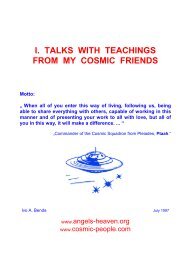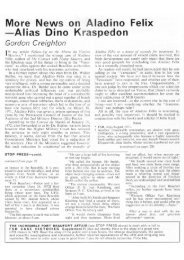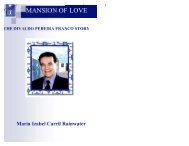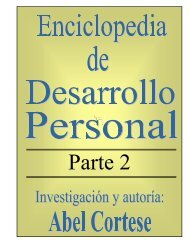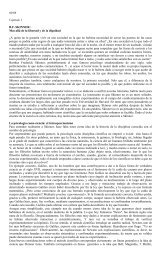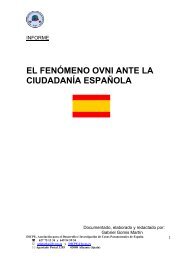The Word That is God
The Word That is God
The Word That is God
You also want an ePaper? Increase the reach of your titles
YUMPU automatically turns print PDFs into web optimized ePapers that Google loves.
of the all, for h<strong>is</strong> final repose. Wherein the sound of the Om attains its final d<strong>is</strong>solution,<br />
thereafter <strong>is</strong> Brahman perceived. <strong>That</strong> yogi who d<strong>is</strong>solves h<strong>is</strong> inner sense [mind] along with<br />
the sound of the Pranava makes for that immortal state of becoming one with Brahman, by<br />
giving up the delusion of ex<strong>is</strong>tence apart from the atman.” (Brahmavidya Upan<strong>is</strong>had 12,13)<br />
“<strong>The</strong> end of the Pranava <strong>is</strong> <strong>That</strong> Which transcends all.” (Brahmavidya Upan<strong>is</strong>had 72)<br />
<strong>The</strong>se verses are speaking of the meditation of Om. Those who follow the thread of the<br />
subtle Pranava to the end will merge in the transcendental Consciousness, beyond Which <strong>is</strong><br />
nothing, but within Which <strong>is</strong> everything.<br />
Brihadaranyaka Upan<strong>is</strong>had<br />
“Om <strong>is</strong> Brahman, the Primeval Being. Th<strong>is</strong> <strong>is</strong> the Veda which the knowers of Brahman<br />
know; through it one knows what <strong>is</strong> to be known.” (Brihadaranyaka Upan<strong>is</strong>had 5.1.1)<br />
Om <strong>is</strong> the Original Being, the Origin of all, and the End of all. Although It has become<br />
expanded, extended, or elaborated into the scriptures called Vedas, the truth <strong>is</strong> that Om alone<br />
<strong>is</strong> the Veda. So do the knowers of Brahman know. Through union-knowledge of Om all <strong>is</strong><br />
known; for Om <strong>is</strong> all that <strong>is</strong>. Om <strong>is</strong> verily both the seed and the fruit of omn<strong>is</strong>cience.<br />
Chandogya Upan<strong>is</strong>had<br />
“One should meditate on th<strong>is</strong> Syllable [Om].” (Chandogya Upan<strong>is</strong>had 1.1.1)<br />
<strong>The</strong> desire to meditate <strong>is</strong> laudable, but we need to know the way to meditate, and th<strong>is</strong><br />
Upan<strong>is</strong>had tells us the way: by silently intoning Om and becoming absorbed in the Consciousness<br />
It embodies.<br />
“<strong>That</strong> <strong>is</strong> the quintessence of the essences, the Supreme, the highest.” (Chandogya Upan<strong>is</strong>had<br />
1.1.3)<br />
If we should wonder why the opening verse of the upan<strong>is</strong>had tells us to meditate on Om,<br />
th<strong>is</strong> verse tells us. <strong>The</strong>re <strong>is</strong> no higher meditation than the meditation of Om, for It <strong>is</strong> the<br />
essence of Divinity. No other interior practice need claim our attention or time.<br />
“Speech [Vak] and Life-force [prana] are joined together in the Syllable Om. Verily, whenever<br />
the pair come together, they fulfil each other’s desire. He who knowing th<strong>is</strong> thus, meditates<br />
on the Syllable, becomes, verily, a fulfiller of desires. Verily, th<strong>is</strong> Syllable <strong>is</strong> of assent, for<br />
whenever one assents to anything he says simply ‘Om.’ What <strong>is</strong> assent <strong>is</strong> fulfillment. He, who<br />
knowing th<strong>is</strong> thus, meditates on the Syllable, becomes, verily, a fulfiller of desires. By th<strong>is</strong><br />
[Om] does the threefold knowledge proceed. Saying Om, one recites: saying Om, one orders:<br />
saying Om, one sings aloud, in honor of that Syllable, with its greatness and its essence. He<br />
who knows th<strong>is</strong> thus, and he who knows not, both perform with It. Knowledge and ignorance,<br />
however, are different. What, indeed, one performs with knowledge, faith, and meditation,<br />
that, indeed becomes more powerful. Th<strong>is</strong>, verily <strong>is</strong> the explanation of th<strong>is</strong> Syllable.” (Chandogya<br />
Upan<strong>is</strong>had 1.1.6-10)<br />
Speech <strong>is</strong> more than exterior verbalization. It <strong>is</strong> the very power of conceptualization and<br />
thought. Furthermore, it <strong>is</strong> the very impulse, the movement, of combined consciousness and<br />
light energy–speech and life-force–that culminates in verbalization. It <strong>is</strong> th<strong>is</strong> union-expansion<br />
20



